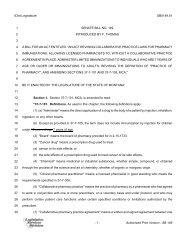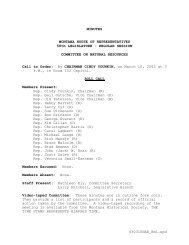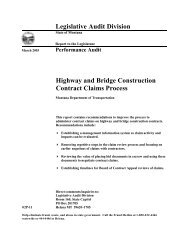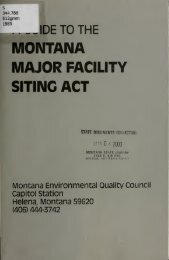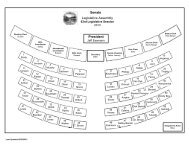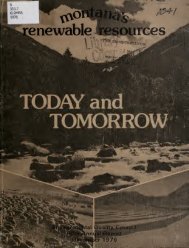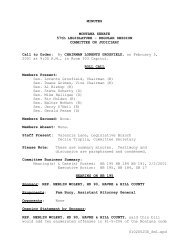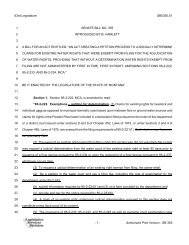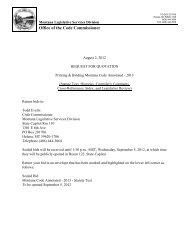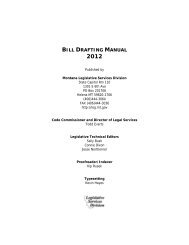Public Comment. Volume III - Montana Legislature
Public Comment. Volume III - Montana Legislature
Public Comment. Volume III - Montana Legislature
Create successful ePaper yourself
Turn your PDF publications into a flip-book with our unique Google optimized e-Paper software.
Crude Of1 & Petroleum Product<br />
Pipelines in <strong>Montana</strong><br />
A Report to the<br />
<strong>Montana</strong> Environmental Quality Council<br />
March, 2000<br />
Crude Oil and Petroleum Products Pipelines in<br />
America<br />
40% of U.S. energy needs provided by oil<br />
97% of U.S. transportation fuels are crude<br />
oil based<br />
. 170,000 miles of pipelines bring crude oil to<br />
refineries and deliver fuels throughout the<br />
United States<br />
525 billion gallons of crude oil and fuels are<br />
pipeline transported annually<br />
65% of all oil and fuels transportation is<br />
handled by pipelines.<br />
Citing a Pipeline and Use of Eminent Domain.<br />
What is a Right-of- Way Easement that Pipelines<br />
Use?<br />
An easement is a negotiated agreement by which a<br />
landowner grants permission to another party, such<br />
as a pipeline company, to use part of the land for a<br />
specific purpose. It is only a right to use the land -<br />
less than full ownership - and is granted in return<br />
for payment. It is important to know that with an<br />
easement the landowner retains the title to the<br />
land. In nearly all cases, buried pipelines do not<br />
interfere with a landowner's ability to continue using<br />
the land in the same manner as in the past.<br />
How do Pipelines Obtain the Right-of- Way?<br />
With respect to a permanent easement, pipeline<br />
companies negotiate agreement terms and<br />
conditions with landowners by signing an easement<br />
document for a permanent right-of-way.<br />
Landowners are compensated for this easement.<br />
Landowners may also be paid for loss of certain<br />
uses of the land during and after construction, loss<br />
of any other resources, and any damage to the<br />
property.<br />
Obtaining a permanent (or perpetual) right-of-way<br />
easement involves a process of good faith<br />
negotiation on the part of the pipeline company and<br />
the landowner. This means providing the<br />
landowner with written information relating to the<br />
pipeline route proposed for that property and<br />
conducting meaningful meetings.to understand<br />
landowner interests.<br />
Compensation for the easement is determined.<br />
Numerous attempts are made and documented on<br />
the part of the parties to reach an agreement. The<br />
amount of compensation for the easement is based<br />
on fair market value set by local experts and at<br />
local rates for similar type property, such as dry<br />
land cultivation or grasslands.<br />
Negotiation also takes place with respect to<br />
compensation for temporary use of the land for<br />
construction. This compensation includes damages<br />
to crops, timber cuts, fences and gates and loss of<br />
any other resources.<br />
If no agreement with the landowner is reached, the<br />
pipeline may acquire the easement under eminent<br />
domain. This is a right given to the pipeline<br />
Crude Oil & Petroleum<br />
Product Pipelines in <strong>Montana</strong><br />
EQC Eminent Domain Study -1 71 -<br />
Page 1



